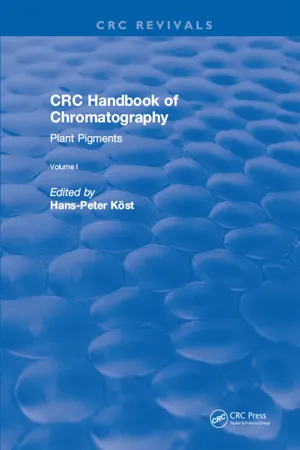
eBook - ePub
Revival: CRC Handbook of Chromatography (1988)
Volume I: Plant Pigments
Hans-Peter Kost
This is a test
- 344 pages
- English
- ePUB (mobile friendly)
- Available on iOS & Android
eBook - ePub
Revival: CRC Handbook of Chromatography (1988)
Volume I: Plant Pigments
Hans-Peter Kost
Book details
Book preview
Table of contents
Citations
About This Book
The CRC Handbook of Chromatography is a series of work-bench references for scientists and researchers using chromatographic systems for the analysis of organic and inorganic compounds.This handbook is an assemblage of tables where, besides data obtained by modern separation methods, older sources often difficult to access have been included to give maximum information. For use in scientific research and routine analysis where the exact determination of plant pigments, because of their light absorbing properties and defined tasks, is necessary.
Frequently asked questions
How do I cancel my subscription?
Can/how do I download books?
At the moment all of our mobile-responsive ePub books are available to download via the app. Most of our PDFs are also available to download and we're working on making the final remaining ones downloadable now. Learn more here.
What is the difference between the pricing plans?
Both plans give you full access to the library and all of Perlego’s features. The only differences are the price and subscription period: With the annual plan you’ll save around 30% compared to 12 months on the monthly plan.
What is Perlego?
We are an online textbook subscription service, where you can get access to an entire online library for less than the price of a single book per month. With over 1 million books across 1000+ topics, we’ve got you covered! Learn more here.
Do you support text-to-speech?
Look out for the read-aloud symbol on your next book to see if you can listen to it. The read-aloud tool reads text aloud for you, highlighting the text as it is being read. You can pause it, speed it up and slow it down. Learn more here.
Is Revival: CRC Handbook of Chromatography (1988) an online PDF/ePUB?
Yes, you can access Revival: CRC Handbook of Chromatography (1988) by Hans-Peter Kost in PDF and/or ePUB format, as well as other popular books in Naturwissenschaften & Industrielle & technische Chemie. We have over one million books available in our catalogue for you to explore.
Information
Part I: Carotenoids
Chromatographic Methods for the Separation of Carotenoids
INTRODUCTION
Many of the vividly red, orange, or yellow flowers and fruits, as well as a number of animals, owe their appearance to the presence of a class of more-or-less unsaturated tetra-terpenoids called “carotenoids”.1 The name comes from the carrot, Daucus carota, from which the prechromatographic “carotene” was isolated (Wackenroder, 1831); only by chromatography could it be shown that there are α-, β-, γ-, and δ-carotenes in the carrot.1, 2, 3
Since then, the carotenoids have been extensively studied in many branches of natural science.1,3, 4, 5 The greater lability of the chlorophylls during autumnal necrosis reveals the carotenoids in the “fall colors” of deciduous trees. Carotenoids are present in the thylakoid membranes of higher plants, algae, and photosynthetic bacteria; here one part of their function is to serve with lesser or greater efficiency as accessory pigments for light-harvesting in photosynthesis. They are not confined to the photosynthetic organelles; however, their presence and synthesis in so many fungi, yeasts, and bacteria which sometimes exhibit intense colors suggest another, wider function: the universal function of carotenoids as photoprotectants (compare References 3, 4, 5, 7, 8, 9).
Carotenoids are also contained in the display apparatus of a variety of flowers;10,11 here they help to attract insects. Many animals contain carotenoids, also, but only via their diet, for they cannot synthesize them as plants can. Chemically, carotenoids are hydrocarbons with numerous conjugated double bonds. The first carotenoid whose structure was elucidated (by Karrer in 1930) was lycopene, the red pigment of tomatoes and other fruits (for historic background, see References 1 and 12).
SOME REMARKS ON CAROTENOID FORMATION AND SOURCES3, 4, 5,7, 8, 9, 10,13, 14, 15
The first “typical” intermediate in carotenoid biosynthesis is isopentenyldiphosphate, which is formed via hydroxymethylglutaryl CoA and then mevalonic acid from the condensation of three molecules of acetyl CoA which arise from the intermediary metabolism of carbohydrates and lipids. By the action of an isomerase, isopentenyldiphosphate is converted to dimethylallyldiphosphate, which easily splits off a diphosphate anion while leaving a carbonium ion. The carbonium ion may now condense head-to-tail with one molecule of isopentenyldiphosphate to form geranyldiphosphate. By the addition of a further molecule of isopentenyldiphosphate, farnesyldiphosphate, a C-15 intermediate, is synthesized. After their formation from this compound, two tetraisoprenoid geranyl-geranyldiphosphates are condensed to molecules of the phytoene, a colorless compound which contains only three conjugated double bonds.
Via stepwise dehydrogenation, phytoene is converted to phytofluene, ζ-carotene, and neurosporene. Eventually, the intensely red-colored lycopene is formed. Lycopene may be converted via ring formation — the α- or β-ionone rings of α- or β-carotene, respectively.
Animal pigments may have undergone considerable modifications; an exampl...
Table of contents
- Cover
- Title Page
- Copyright Page
- Table of Contents
- Part I: CAROTENOIDS
- PART II: PORPHYRINS (EXCLUSIVE OF CHLOROPHYLLS)
- PART III: CHLOROPHYLLS
- INDEX
Citation styles for Revival: CRC Handbook of Chromatography (1988)
APA 6 Citation
Kost, H.-P. (2019). CRC Handbook of Chromatography (1st ed.). CRC Press. Retrieved from https://www.perlego.com/book/1501238/crc-handbook-of-chromatography-volume-i-plant-pigments-pdf (Original work published 2019)
Chicago Citation
Kost, Hans-Peter. (2019) 2019. CRC Handbook of Chromatography. 1st ed. CRC Press. https://www.perlego.com/book/1501238/crc-handbook-of-chromatography-volume-i-plant-pigments-pdf.
Harvard Citation
Kost, H.-P. (2019) CRC Handbook of Chromatography. 1st edn. CRC Press. Available at: https://www.perlego.com/book/1501238/crc-handbook-of-chromatography-volume-i-plant-pigments-pdf (Accessed: 14 October 2022).
MLA 7 Citation
Kost, Hans-Peter. CRC Handbook of Chromatography. 1st ed. CRC Press, 2019. Web. 14 Oct. 2022.